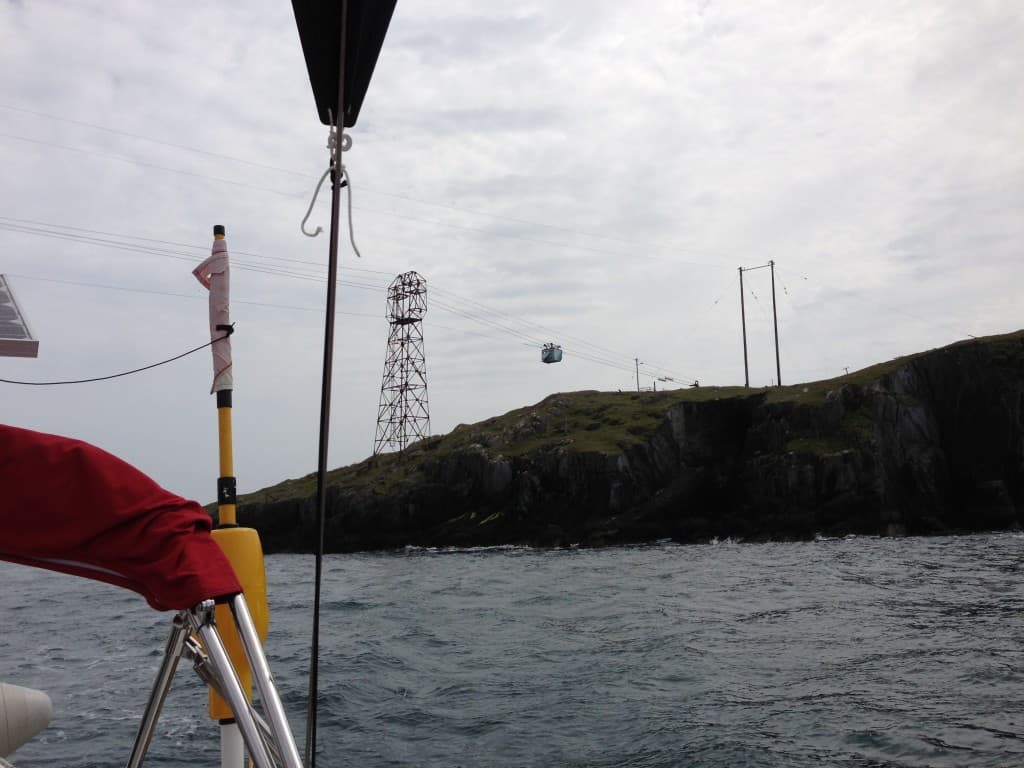 We left Lawrence Cove Marina on Monday and tacked out through Bere Island Sound before rounding Crow Head and passing through the sound between the mainland and Dursey Island. This sound narrows like a funnel as the tide slooshed us through. There is a rather ancient cable car linking the island to the mainland and our mast just fitted under the cable.
We left Lawrence Cove Marina on Monday and tacked out through Bere Island Sound before rounding Crow Head and passing through the sound between the mainland and Dursey Island. This sound narrows like a funnel as the tide slooshed us through. There is a rather ancient cable car linking the island to the mainland and our mast just fitted under the cable.
We thus came into the Kenmare River. Actually this is another ria, like the other bays. The story goes that, when the Ordnance Survey was recording names for these places, the local land owner insisted it be called a river because his salmon rights were limited to rivers. We sailed some fourteen miles up the bay and into a sheltered anchorage at Kilmakilloge, nestling in the mountains, where we sat out gales and rain for two nights. We think it was a beautiful spot, but the mountains were covered in mist throughout our stay.
On Wednesday we emerged for a long beat against the wind out of the Kenmare River and round the Kerry peninsula. Unfortunately the wind failed as we arrived off the headlands and there was an unpleasantly confused sea as the atlantic swell was reflected back off the vertical cliffs and so we had to resort to the engine. We were again shrouded in mist and were unable to see the very spectacular cliffs. We did see lots of puffins as we rounded Puffin Island. As we came to Valentia Island we were about to seek refuge in Port Magee when the wind returned and we were able to sail across Dingle Bay to the port of Dingle.
 There are a number of rocky pinnacles off these headlands. None have harbours and most not even an anchorage, rising straight out of deep water. The sides heave with the Atlantic swell. We have abandoned any thoughts of visiting them. Back in the sixth century there was a monastery on Skelling Michael eight miles off shore and much further from any harbour. It is amazing to reflect on the seamanship that must have been needed to establish this. These sites also contain several beehive-shaped dry stone huts or cells from the same time, which are in good shape having withstood the weather for 1500 years.
There are a number of rocky pinnacles off these headlands. None have harbours and most not even an anchorage, rising straight out of deep water. The sides heave with the Atlantic swell. We have abandoned any thoughts of visiting them. Back in the sixth century there was a monastery on Skelling Michael eight miles off shore and much further from any harbour. It is amazing to reflect on the seamanship that must have been needed to establish this. These sites also contain several beehive-shaped dry stone huts or cells from the same time, which are in good shape having withstood the weather for 1500 years.
We were escorted into Dingle Harbour by Fungi the bottle-nosed dolphin. Fungi has been resident around the harbour mouth for almost thirty years and he makes a point of welcoming every boat. He is extremely friendly and has even been known to make a present of fish to divers, although he never accepts anything himself, preferring to catch his own. Dingle is a lively town with lots of shops, bars and restaurants. We have been sheltering here from wind again and re-stocking, as there is little by way of harbours as we head north from here.

